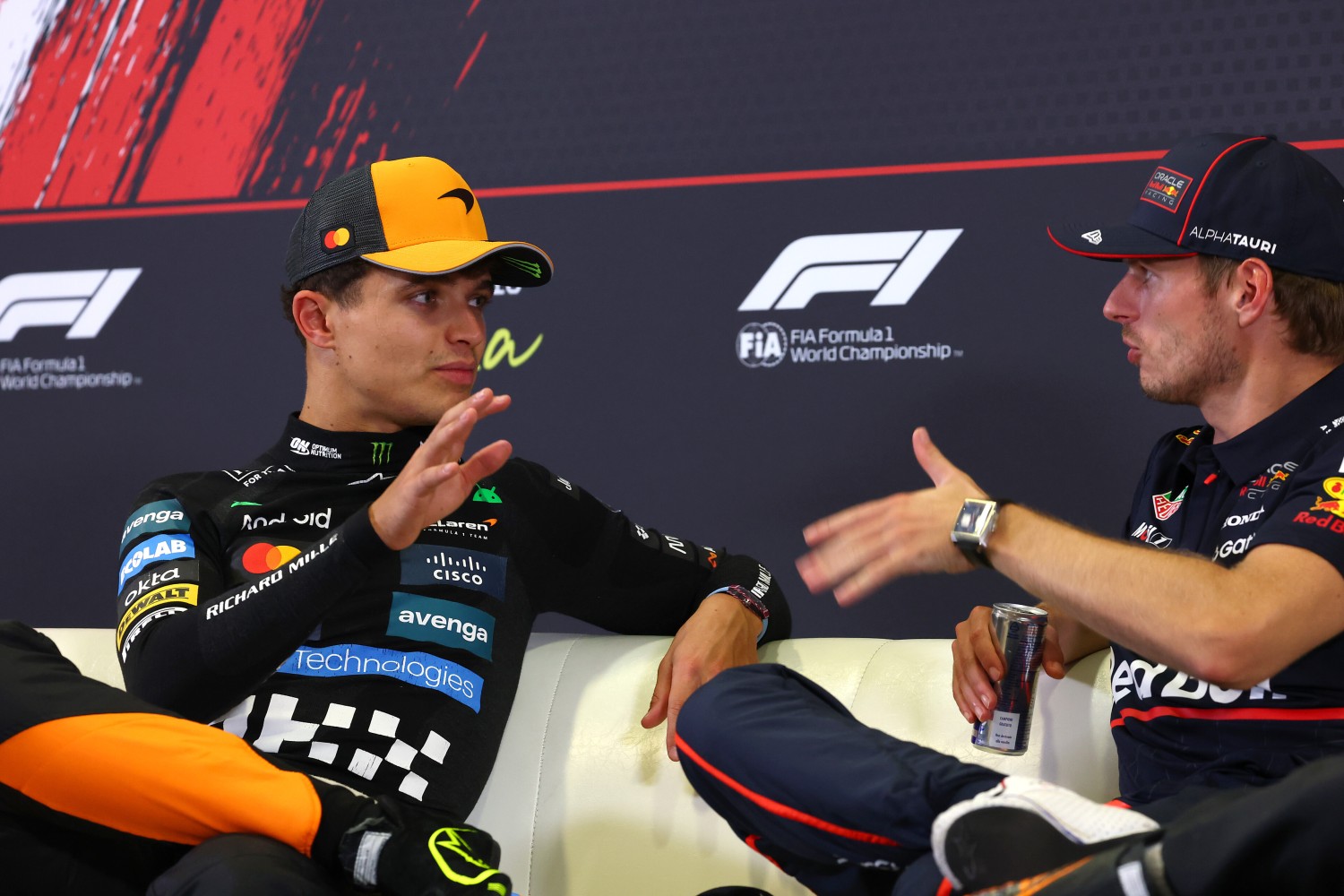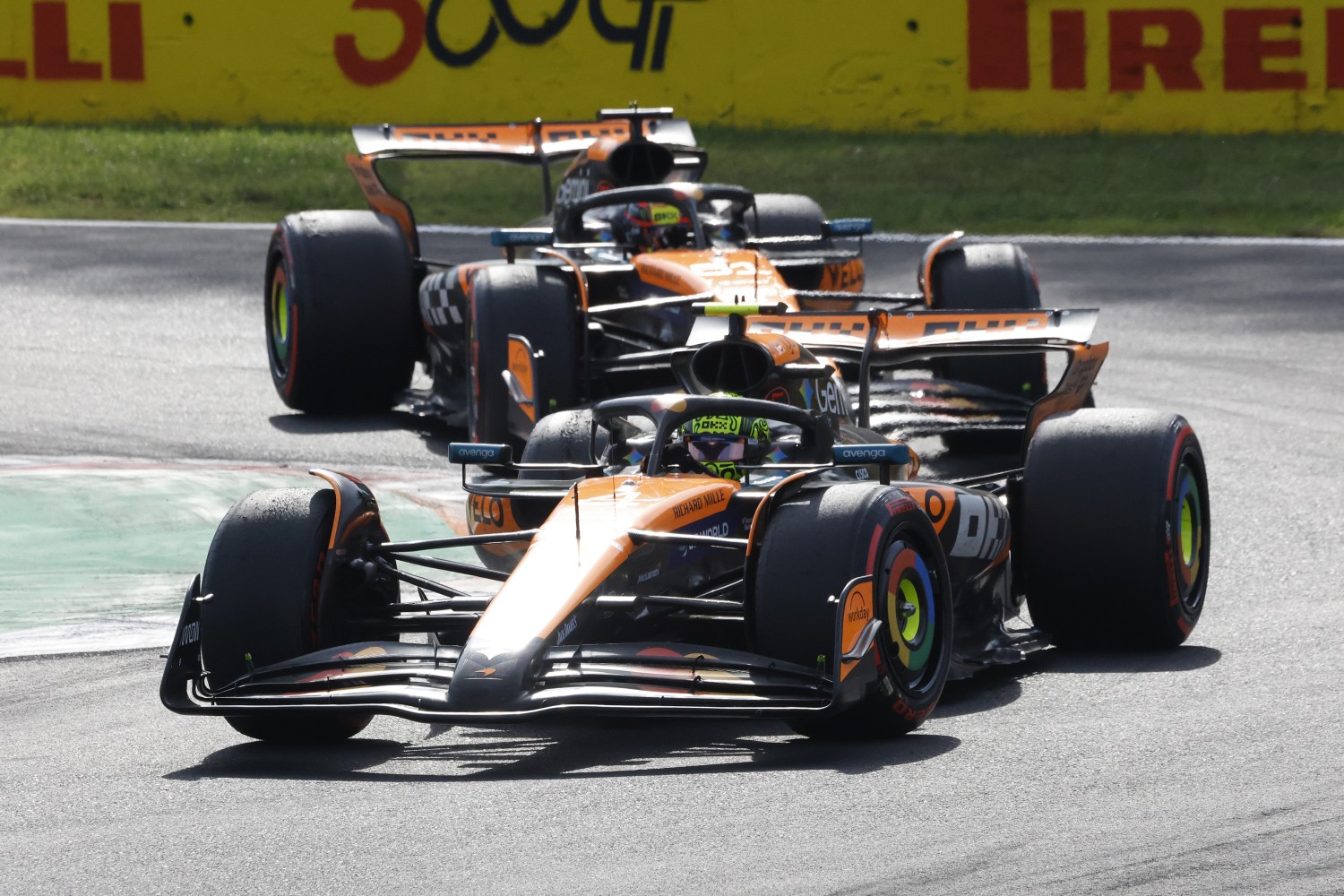F1 News: Will McLaren’s Papaya Rules come back to bite them in the posterior?
The late summer sun cast long shadows over the Autodromo Nazionale Monza, the Temple of Speed, as the 2025 Italian Grand Prix roared to its climax.
–by Mark Cipolloni–
McLaren’s papaya-orange MCL39s sliced through the air, Lando Norris and Oscar Piastri locked in a tense intra-team battle for second place behind Max Verstappen’s untouchable Red Bull. The tifosi’s cheers echoed through the grandstands, but in the McLaren garage, a storm was brewing—one that would crack open a can of worms the team could scarcely afford.
McLaren’s “Papaya Rules,” a set of principles meant to ensure fair racing between their star drivers, had been the talk of the paddock all season. Conceived to avoid favoritism and collisions while maximizing the team’s championship hopes, the rules boiled down to one core tenet: race hard, but don’t take each other out. Simple in theory, but at Monza, they became a lightning rod for controversy.
The race had started with promise. Norris, starting from outside pole, and Piastri, behind in row 2, were poised to dominate. But a controversial first lap saw Norris lose the lead to Max Verstappen and drop to 2nd.
Verstappen would go on to dominate the race, with the two McLaren cars almost 20 seconds behind.
McLaren’s strategy leaned on their car’s superior tire management, delaying pit stops to the final 10 laps to switch to softs, hoping for a late safety car to shake up the order. It was a gamble, and it backfired spectacularly.
Piastri pitted first to fend off Leclerc’s undercut, emerging ahead after Norris suffered a disastrous 5.9-second pit stop. Suddenly, Piastri was in second, Norris in third, and the championship standings—where Piastri led Norris by 34 points—hung in the balance.
Then came the radio call that would ignite the paddock. “Oscar, please let Lando pass, and then you’re free to race,” said Piastri’s race engineer, Tom Stallard. The Australian’s response was icy: “We said a slow pit stop was part of racing. I don’t really get what’s changed here, but if you want to do it, I’ll do it.”
Piastri complied, slowing to let Norris reclaim second place, but the move sparked outrage. The tifosi, already prickly from Ferrari’s defeat, booed Norris on the podium. Social media erupted, with fans accusing McLaren of undermining their own “Papaya Rules” by favoring Norris.
“If fairness is the goal, why punish Oscar for Lando’s pit crew fumble?” one X post fumed. Another called it “a slap in the face to team spirit.” The decision shaved Piastri’s championship lead to 31 points, a bitter pill for the Australian saw a six point swing in the point battle between the two.
Team principal Andrea Stella faced the media scrum, his face taut but composed. “Our intent was clear: the inverted pit stop order wasn’t meant to swap positions,” he said. “We prioritize fairness and consistency with our principles. The slow pit stop wasn’t just bad luck—it disrupted the race order we intended.”
But his explanation only poured fuel on the fire. Critics, including Mercedes’ Toto Wolff, warned McLaren had set a dangerous precedent. “When things get heated later in the season, this call will haunt them,” Wolff said. Even Verstappen, grinning on the radio, couldn’t resist a jab: “I had to laugh a little about Oscar having to give up the position.”

Back in the McLaren motorhome, the air was thick with tension. Piastri, ever the stoic, kept his frustration in check but hinted at unease. “I said what I needed to on the radio,” he told reporters, his voice clipped. “I’m not going to go against the team, but we’ll discuss it.”
Norris, meanwhile, tried to downplay the drama. “There are no Papaya Rules anymore,” he said with a forced smile to DAZN. “It’s about fairness. The team comes first, then the drivers.” But his words rang hollow to those who saw Piastri’s compliance as a sacrifice of his own championship fight.
The fallout rippled beyond Monza. The “Papaya Rules,” once a badge of McLaren’s commitment to equitable racing, now seemed like a hollow promise. Fans and pundits questioned whether McLaren was quietly backing Norris, who had trailed Piastri all season but was seen by some as the team’s long-term star. The 2024 Hungarian Grand Prix, where Norris reluctantly gave up a win to Piastri after a similar pit strategy mix-up, was dragged back into the spotlight. “This is Hungary all over again,” one journalist wrote, “but now it’s Oscar on the losing end.”
In the drivers’ lounge, Piastri sat quietly, scrolling through his phone. A message from his manager, Mark Webber, popped up: “Keep your head down, mate. You’re faster than this noise.” Piastri knew the championship was still within reach, but Monza had exposed a crack in McLaren’s unity. The team’s gamble to chase a win over Verstappen by delaying pit stops had forced a choice that alienated half their fanbase and strained trust between their drivers.

As the circus packed up for Baku, Stella called a closed-door meeting with Norris and Piastri. “We’re a team,” he told them, “and we’ll sort this out. But the world’s watching, and we can’t afford another misstep.”
The “Papaya Rules” were meant to unify, but at Monza, they’d opened a Pandora’s box of doubt, rivalry, and scrutiny. With eight races left in 2025, McLaren’s dream of a drivers’ championship was alive—but the worms were out, and they weren’t going back in the can.
